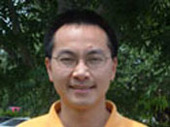Back when I went to Rice, 30 years ago now, it was known primarily as an engineering school. Since the 1983 Buckyball discovery hard sciences, especially chemistry, have taken prominence. Which is fine.
But I do like it when the engineers kick it up a notch, and now the team of Michael Wong has kicked it up to notches unknown, developing a new way to create "quantum dots" which promises cheaper, and more plentiful, solar energy.
Above, a description of how this technology will be applied in solar panels.
We’re talking here of "four-legged cadmium selenide
quantum dots," also called tetrapods or quantum dots. These are very
efficient at converting sunlight into electricity. Many large-scale
proposals for collecting energy from rooftops are based on using panels
with lots of quantum dots on them.
Trouble is current methods for making the dots use alkylphosphonic acid, which is expensive, highly caustic, very nasty, but has potential uses as a flame retardant. Instead, the Wong way is to use cetyltrimethylammonium
bromide, which costs much less, is much less caustic and (wonder of
wonders) delivers a much higher yield.











